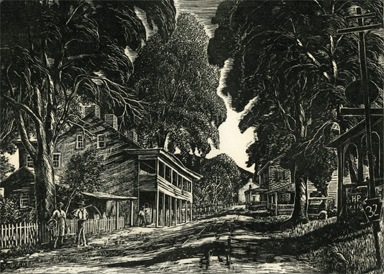Pullinger Prints and Woodblocks Opening at Michener Saturday


VILLAGE HOTEL: The hotel in Lumberville, Pa, that wood engraver Herbert Stewart Pullinger (1878-1961) depicts here brings to mind more tranquil days. Just under 10 by 12 inches, the image on paper is one of over 20 works by the artist in the exhibition “Spirit of the Everyday: Prints by Herbert Pullinger” opening at the James A. Michener Art Museum Saturday, December 20, and continuing through March 29. For more information, call (215) 340-9800, or visit: MichenerArtMuseum.org. (Image Courtesy of the Michener Museum)
A small exhibition of works by one of America’s foremost engravers goes on display at the James A. Michener Museum of Art Saturday. For lovers of the wood cut and the art of wood-engraving, this show should not be missed.
Titled, “Spirit of the Everyday: Prints by Herbert Pullinger,” the exhibition showcases a select group of wood engravings and wood blocks given to the museum by Ann and Martin Snyder. According to the show’s curator, Constance Kimmerle, the artist was Mr. Snyder’s great uncle.
This will be the first time the collection has been shown at the Michener. It is perfectly suited to the intimate setting of the gallery space devoted to works on paper, the Bette and Nelson Pfundt Gallery, and a perfect fit for the Michener’s mission of collecting, preserving, interpreting, and exhibiting American Art, with a focus on art of the Bucks County region.
Herbert S. Pullinger (1878-1961) emerged as one of America’s foremost wood engravers during the 1920s. Born and raised in Philadelphia, where he lived, he also spent many summers in Lumberville, Pa. He studied at the Pennsylvania Museum School of Industrial Arts (University of the Arts) and at the Pennsylvania Academy of the Fine Arts and taught graphic arts and watercolor at the Pennsylvania Museum School of Industrial Art. Several of his works, such as his 1934 engraving of Dock Street from Delaware Avenue, are in the collection of the Philadelphia Museum of Art, although not currently on view.
“It seemed appropriate to show this work in the wintertime because the collection includes several snow scenes,” said Ms. Kimmerle, the museum’s curator of collections, who had not been familiar with the artist’s work until the collection was donated to the museum in 2005.
Ms. Kimmerle, who has been with the Michener for some 14 years, is particularly fond of Mr. Pullinger’s snow scenes and country scenes. “The collection includes some very nice images of Bucks County and some of Philadelphia; they can be divided into urban scenes, country scenes, and scenes of heavy industry.”
The images depict everyday life, landscapes, houses, stores, barns, post offices, bridges, canals, lighthouses, coal breakers, and steel furnaces that the artist encountered in Pennsylvania and New Jersey during the 1920s and 1930s.
“Expressing the ‘spirit of the everyday’ was a genuine concern for many American artists at the beginning of the 20th century, and Herbert Pullinger was no exception,” commented Ms. Kimmerle. “As the works in the show reveal, whether he was rendering a snow scene in rural Bucks County or a dynamic industrial scene in Pittsburgh, Pullinger’s creations moved beyond the mere description of a place to fully capture its distinctive spirit and vital energy.”
Presented by Vivian Banta and Robert Field, “Spirit of the Everyday: Prints by Herbert Pullinger,” will be at the James A. Michener Art Museum, 138 South Pine Street in Doylestown, from December 20 through March 29. The Museum is open Tuesday through Friday, 10 a.m. to 4:30 p.m.; Saturday, 10 a.m. to 5 p.m.; Sunday, noon to 5 p.m. For more information, call (215) 340-9800, or visit: MichenerArtMuseum.org.

